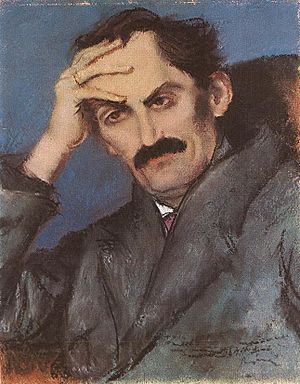Mihály Babits facts for kids
Quick facts for kids
Mihály Babits
|
|
|---|---|
 |
|
| Born | 26 November 1883 Szekszárd, Austria-Hungary |
| Died | 4 August 1941 (aged 57) Budapest, Hungary |
| Nationality | Hungarian |
| Period | 1900–1941 |
| Genre | Poetry, Short stories, Novels Literary history Essays, lyric poetry |
| Spouse | Ilona Tanner (pen name: Sophie Török) |
| Relatives | Mother: Auróra Kelemen Father: Mihály Babits |
Mihály Babits (born November 26, 1883 – died August 4, 1941) was a famous Hungarian poet, writer, and translator. He was known for his poems that often talked about strong religious feelings. He also wrote novels, like "The Children of Death" (1927), which looked into how people think and feel.
Contents
Early Life and Education
Mihály Babits was born in Szekszárd, a town in Hungary. He went to the University of Budapest from 1901 to 1905. There, he met other important writers like Dezső Kosztolányi and Gyula Juhász.
Becoming a Teacher
After university, Babits became a teacher. He taught at different schools in Hungary. He worked in places like Baja (1905–06) and Szeged (1906–08). Later, he taught in Újpest (1911) and Budapest (1912–18).
Literary Career
Babits started to become well-known for his poems around 1908. This was an important time for his writing.
Travels and Translations
In 1908, he traveled to Italy. This trip made him very interested in the famous Italian poet Dante. Babits made more trips to Italy later on. Because of his interest, he translated Dante's long poem, Divine Comedy, into Hungarian. He translated "Hell" in 1913, "Purgatory" in 1920, and "Paradise" in 1923.
University and Pacifism
After the Hungarian Revolution of 1919, Babits became a professor. He taught about foreign literature and modern Hungarian literature at the University of Budapest. However, he was soon removed from his job. This happened because he believed in pacifism, which means he was against war and violence.
Work with Nyugat Magazine
In 1911, Babits started working for a very important Hungarian magazine called Nyugat. This magazine was a big part of Hungarian literature. In 1929, he became the main editor of Nyugat. He shared this role with another writer, Zsigmond Móricz, for a few years. Babits stayed as editor until he passed away.
Novels and Psychology
Babits also wrote novels. His 1918 novel, The Nightmare (also called King's Stork), was a science fiction story. It explored ideas about a split personality, which was influenced by Freudian psychology. He also wrote "The Pilot Elza, or the Perfect Society," which was about a perfect future world.
Later Life
In 1921, Mihály Babits married Ilona Tanner. She later became a poet herself, using the name Sophie Török. Two years later, they moved to Esztergom.
Awards and Recognition
Babits was recognized for his literary work. In 1927, he became a member of the "Kisfaludy Társaság" (Kisfaludy Society). In the same year, he was made a trustee of the Baumgarten Prize. This prize was given to talented Hungarian writers.
Final Years
In 1937, Babits was diagnosed with laryngeal cancer. He passed away in Budapest in 1941.
His Works and Legacy
Mihály Babits is most famous for his lyric poetry. This type of poetry often expresses strong emotions. His poems were influenced by classical and English styles. He also wrote many essays. Babits translated many works from different languages, including English, French, German, Greek, Italian, and Latin.
Today, you can visit a museum in Szekszárd that shows Mihály Babits's life and work. It helps people learn more about this important Hungarian writer.
- 1988: 21 Poems (21 Vers), translated by István Tótfalusi (Maecenas, 1994).
See also
 In Spanish: Mihály Babits para niños
In Spanish: Mihály Babits para niños

